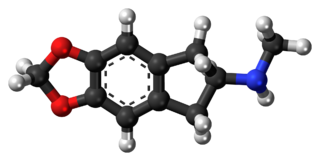
Empathogens or entactogens are a class of psychoactive drugs that induce the production of experiences of emotional communion, oneness, relatedness, emotional openness—that is, empathy or sympathy—as particularly observed and reported for experiences with 3,4-methylenedioxymethamphetamine (MDMA). This class of drug is distinguished from the classes of hallucinogen or psychedelic, and amphetamine or stimulants. Major members of this class include MDMA, MDA, MDEA, MDOH, MBDB, 5-APB, 5-MAPB, 6-APB, 6-MAPB, methylone, mephedrone, GHB, αMT, and αET, MDAI among others. Most entactogens are phenethylamines and amphetamines, although several, such as αMT and αET, are tryptamines. When referring to MDMA and its counterparts, the term MDxx is often used. Entactogens are sometimes incorrectly referred to as hallucinogens or stimulants, although many entactogens such as ecstasy exhibit psychedelic or stimulant properties as well.

3,4-Methylenedioxyamphetamine is an empathogen-entactogen, psychostimulant, and psychedelic drug of the amphetamine family that is encountered mainly as a recreational drug. In its pharmacology, MDA is a serotonin–norepinephrine–dopamine releasing agent (SNDRA). In most countries, the drug is a controlled substance and its possession and sale are illegal.

5-(2-Aminopropyl)-2,3-dihydro-1H-indene (5-APDI), also known as indanylaminopropane (IAP), IAP (psychedelic), 2-API(2-aminopropylindane), indanametamine, and, incorrectly, as indanylamphetamine, is an entactogen and psychedelic drug of the amphetamine family. It has been sold by online vendors through the Internet and has been encountered as a designer drug since 2003, but its popularity and availability has diminished in recent years.

α-Pyrrolidinopropiophenone (α-PPP), is a stimulant drug. It is similar in structure to the appetite suppressant diethylpropion and has analogous effects in animals. Little is known about this compound, but it has been detected by laboratories in Germany as an ingredient in "ecstasy" tablets seized by law enforcement authorities. This drug has been found to produce stimulant effects in animals and presumably also produces these effects in humans, based on the context in which it has been found.

3,4-Ethylenedioxy-N-methylamphetamine (EDMA) is an entactogen drug of the methamphetamine class. It is an analogue of MDMA where the methylenedioxy ring has been replaced by an ethylenedioxy ring. EDMA was first synthesized by Alexander Shulgin. In his book PiHKAL, the dosage is listed as 150–250 mg, and the duration listed as 3–5 hours. According to Shulgin, EDMA produces a bare threshold consisting of paresthesia, nystagmus, and hypnogogic imagery, with few to no other effects. Scientific research has demonstrated that EDMA acts as a non-neurotoxic serotonin releasing agent with moderately diminished potency relative to MDMA, and with negligible effects on dopamine release.

5-(2-Aminopropyl)-2,3-dihydrobenzofuran is a putative entactogen drug of the phenethylamine and amphetamine classes. It is an analogue of MDA where the heterocyclic 3-position oxygen from the 3,4-methylenedioxy ring has been replaced by a methylene bridge. 6-APDB is an analogue of 5-APDB where the 4-position oxygen has been replaced by a methylene bridge instead. 5-APDB was developed by a team led by David E. Nichols at Purdue University as part of their research into non-neurotoxic analogues of MDMA.

MDAI (5,6-methylenedioxy-2-aminoindane) is a drug developed in the 1990s by a team led by David E. Nichols at Purdue University. It acts as a non-neurotoxic and highly selective serotonin releasing agent (SSRA) in vitro and produces entactogen effects in humans.

3-Methoxy-4-methylamphetamine (MMA) is an entactogen and psychedelic drug of the phenethylamine and amphetamine classes. It was first synthesized in 1970 and was encountered as a street drug in Italy in the same decade. MMA was largely forgotten until being reassayed by David E. Nichols as a non-neurotoxic MDMA analogue in 1991, and has subsequently been sold as a designer drug on the internet since the late 2000s (decade).

5,6-Methylenedioxy-N-methyl-2-aminoindane (MDMAI), is a drug developed in the 1990s by a team led by David E. Nichols at Purdue University. It acts as a non-neurotoxic and highly selective serotonin releasing agent (SSRA) in animals and a putative entactogen in humans.
A serotonin releasing agent (SRA) is a type of drug that induces the release of serotonin into the neuronal synaptic cleft. A selective serotonin releasing agent (SSRA) is an SRA with less significant or no efficacy in producing neurotransmitter efflux at other types of monoamine neurons.

TDIQ is a drug used in scientific research, which has anxiolytic and anorectic effects in animals. It has an unusual effects profile in animals, with the effects generalising to cocaine and partially to MDMA and ephedrine, but the effects did not generalise to amphetamine and TDIQ does not have any stimulant effects. It is thought these effects are mediated via a partial agonist action at Alpha-2 adrenergic receptors, and TDIQ has been suggested as a possible drug for the treatment of cocaine dependence.

2-Aminotetralin (2-AT), also known as 1,2,3,4-tetrahydronaphthalen-2-amine (THN), is a stimulant drug with a chemical structure consisting of a tetralin group combined with an amine.

2-Amino-1,2-dihydronapthalene (2-ADN), also known as 2-aminodilin (2-AD), is a stimulant drug. It is a rigid analogue of phenylisobutylamine and substitutes for amphetamine in rat discrimination tests, although at approximately one fourth the potency. It is closely related to 2-aminotetralin (2-amino-1,2,3,4-tetrahydronaphthalene), which also substitutes for amphetamine, and is about two times as potent in comparison.

6-Chloro-2-aminotetralin (6-CAT) is a drug which acts as a selective serotonin releasing agent (SSRA) and is a putative entactogen in humans. It is a rigid analogue of para-chloroamphetamine (PCA).

2-Methyl-3,4-methylenedioxyamphetamine (2-methyl-MDA) is an entactogen and psychedelic drug of the amphetamine class. It acts as a selective serotonin releasing agent (SSRA), with IC50 values of 93nM, 12,000nM, and 1,937nM for serotonin, dopamine, and norepinephrine efflux. 2-Methyl-MDA is more potent than MDA and 5-methyl-MDA. However, it is slightly more selective for serotonin over dopamine and norepinephrine release in comparison to 5-methyl-MDA.

6-(2-Aminopropyl)-2,3-dihydrobenzofuran is a stimulant and entactogen drug of the phenethylamine and amphetamine classes. It is an analogue of MDA where the heterocyclic 4-position oxygen from the 3,4-methylenedioxy ring has been replaced with a methylene bridge. 5-APDB (3-Desoxy-MDA) is an analogue of 6-APDB where the 3-position oxygen has been replaced with a methylene instead. 6-APDB, along with 5-APDB, was first synthesized by David E. Nichols in the early 1990s while investigating non-neurotoxic MDMA analogues.

MDMAT (6,7-methylenedioxy-N-methyl-2-aminotetralin) is a putative, non-neurotoxic, selective serotonin releasing agent (SSRA) and entactogen drug. It is the N-methylated derivative of MDAT, similarly to the relationship of MDMA to MDA or MDMAI to MDAI.

6-Methyl-3,4-methylenedioxyamphetamine (6-Methyl-MDA) is an entactogen and psychedelic drug of the amphetamine class. It was first synthesized in the late 1990s by a team including David E. Nichols at Purdue University while investigating derivatives of 3,4-methylenedioxyamphetamine (MDA) and 3,4-methylenedioxy-N-methylamphetamine (MDMA).

4-Chlorophenylisobutylamine, also known as 4-chloro-α-ethylphenethylamine, is an entactogen and stimulant drug of the phenethylamine class. It is an analogue of para-chloroamphetamine (PCA) where the alpha position methyl has been replaced with an ethyl group.

Difluoromethylenedioxyamphetamine is a substituted derivative of 3,4-methylenedioxyamphetamine (MDA), which was developed by Daniel Trachsel and coworkers, along with the corresponding fluorinated derivatives of MDMA, MDEA, BDB and MBDB, with the aim of finding a non-neurotoxic drug able to be used as a less harmful substitute for entactogenic drugs such as MDMA. Since a major route of the normal metabolism of these compounds is scission of the methylenedioxy ring, producing neurotoxic metabolites such as alpha-methyldopamine, it was hoped that the difluoromethylenedioxy bioisostere would show increased metabolic stability and less toxicity.



















